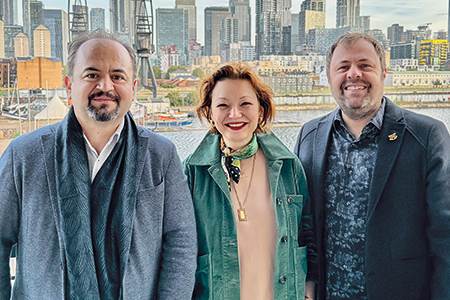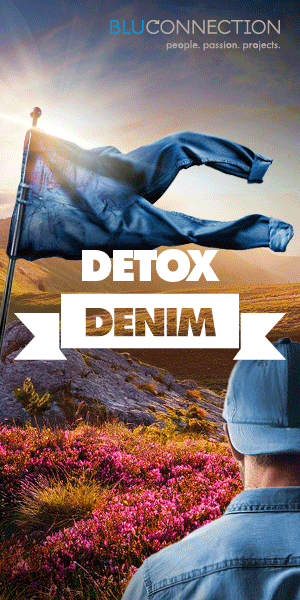A stitch in time

Denim industry stalwart Romain Narcy, an Ereks & Era partner since 2020, details the optimistic yet pragmatic vision behind new venture Rematters – Textile Recycling Solutions for us.
Many congratulations again on the launch of Rematters! How have your denim learnings over the years informed your decision to set up your own textile recycling consultancy at this time?
As a conscious producer, we are fully aware [at Ereks-Blue Matters] of all the effort that goes into creation and production, but manufacturing does have a strong environmental impact. We struggle with the notion that what we make can be seen as throwaway fashion or consumable goods. How can we accept that up to 30% of product can end up in landfill, or incinerated, even before it reaches the consumer, for example? So, considering all these factors, we have decided to evolve and fight to revive the perceived value of products. At end of life, fashion and fabrics should be seen as [useful] secondary raw material, rather than waste.
From a more macro perspective, in this time of overconsumption and overproduction, we have decided to pursue positive impact in our sphere. After much thought, we decided to focus on addressing the issue of textile waste. Our aim is to move the needle on the dramatic figure shared by the Ellen MacArthur Foundation several years ago now, in 2017: less than 1% of the 100 billion garments produced every year are recycled into ‘new’ textiles or clothing. We still have a way to go to valourise 100% of the fabrics we produce, but we are up to the challenge and will do our part! It is time to scale up!
New regulations such as the European Green Deal, including CO2 taxation, extended producer responsibility (EPR) and principles of Ecodesign, will also force our industry to change. It seems that the needs of the planet, policy and public perspective are all converging, so it feels like the perfect time for action in the area of repair, reuse and recycling.
Tell us about the team of experts you have assembled and how you all came to meet.
Our team of experts has more than half a century of textile industry experience combined. We all came to meet at various stages in life. One of my business partners in this venture is my wife of more than twenty years, Ece Muftuoglu-Narcy, for instance. Ece studied international relations and has worked as general secretary for a leading NGO, working on protecting Turkish cultural heritage and the environment. She has had significant experience in managing big-scale, European Union-financed projects in our industry, too. This ultimately led to her joining Ereks-Blue Matters over five years ago. It was during covid that we together decided that the moment for taking action on circularity had come. My wife is now our chief strategy officer, while I am chief executive. It brings a lot of intellectual satisfaction to share such deeply held values with the person you spend most of your time with.
We met our executive director, Hakan Ucar, through a series of webinars organised by the Istanbul Textile and Raw Materials Exporters’ Association. I was presenting on sustainability and circularity in fashion and the need for industry change. He liked what I’d said and contacted me via LinkedIn afterwards, saying that he would like to meet me to look at possible avenues for collaboration – we clicked and made it happen! Hakan is a chemical engineer by training, with very strong international experience in Turkey and across Europe as a research and development director, specialising in materials and processes for multinational textile enterprises.
We are now finalising the recruitment of an experienced business development director and have hired a young graduate to manage our customer relationship management. I must admit that our purpose-driven venture leads us to meet fantastically motivated candidates; individuals that desire to be agents of change. It is always a source of extra satisfaction when you hire people that share in your vision.
Beyond our core team, we can additionally draw from a fantastic pool of textile experts from the fields of marketing, industrial design, finance, impact funding and more. This ecosystem reflects the connections we have made during our careers in business and fashion so far. Again, when you have a clear and noble mission, you tend to attract a tremendous number of highly valuable individuals, I have found. It feels almost magnetic!
What are some of the fashion industry’s most concerning blind spots or knowledge gaps (and, therefore, future opportunities) when it comes to implementing recycling systems for post-consumer fabric waste, would you say?
There are a number of blind spots and knowledge gaps in the fashion industry when it comes to implementing recycling systems for post-consumer fabric waste. Some of these include:
Lack of infrastructure. The fashion industry lacks the infrastructure necessary to collect, sort and process post-consumer textile waste efficiently. There is need for improved recycling facilities and technologies that can handle a broader range of material.
Limited consumer awareness. Many consumers are not aware of the importance of recycling their clothes and the options available to them. There is a need for increased education and awareness campaigns to better inform consumers about recycling’s benefits and how to properly dispose of their clothing.
Complex material composition. Apparel is often made from a blend of different fibres, such as cotton, polyester and elastane, making it a challenge to separate and recycle clothing effectively. Developing technologies capable of separating and processing mixed-fibre fabrics efficiently is therefore crucial.
Chemical processes. Certain materials, such as those treated with dyes, finishes or coatings, pose a challenge when it comes to recycling. Finding environmentally friendly and cost-effective methods to removing chemical treatments and ultimately recycling the fabric is an ongoing challenge.
Scaling up recycling processes. Most industry recycling initiatives remain on a small scale right now. Maintaining quality standards during scale-up is a must, to ensure they have a meaningful impact.
Collaboration and supply chain integration. Fashion is complex and the industry relies on multiple stakeholders to function as it does, from designers and manufacturers to retailers and consumers. There is a need for improved collaboration and integration across the supply chain, to implement effective recycling systems and ensure materials are kept in circulation.
Addressing these blind spots and knowledge gaps presents many opportunities for innovation and collaboration. Developing advanced recycling technologies, promoting consumer awareness, investing in infrastructure and fostering partnerships throughout the supply chain can unlock the potential for a more sustainable and circular fashion ecosystem.
What should “a comprehensive solution for the entire circular supply chain” look like? And how does Rematters hope to help clients and partners realise this?
Rematters aims to use its textile expertise to help clients and partners realise a comprehensive solution for the entire circular supply chain. We provide tailored recommendations for optimising sorting and recycling processes. Our clients include collectors, sorters, recyclers and brands looking to enhance circularity in their textile products.
We utilise our network and connections to ensure that correct inputs, such as post-industrial or post-consumer textile waste feedstocks, are obtained. This includes providing the outputs needed for mechancial, thermo-chemical or chemical recycling, such as sorted garments or sorted and cleaned clippings, plus fibres for spinners and weavers. We harness our technical and operational know-how to assemble the best ecosystems and networks for our circular textile systems possible, to facilitate partner companies’ seamless transition towards more circular and sustainable textile production and consumption.
What does your vision of a state-of-the-art textile recycling ecosystem consist of? For instance, what should some of its main features, parts or components be?
A state-of-the-art textile recycling ecosystem would include the following:
- Automated sorting. One of the main challenges to textile recycling is sorting garments based on condition, material composition and their potential reuse. A state-of-the-art system would involve advanced technology such as artificial intelligence (AI) and machine learning algorithms, to automate the sorting process and improve both efficiency and accuracy.
- Wearables/resaleable goods. For items that can be resold or reused, AI and machine learning would be utilised to identify high-quality wearables and separate them efficiently, to help maximise their value and make sure they do not end up landfilled, or littering unlawful dumpsites in the Southern Hemisphere.
- Sanitisation and contamination removal. Post-consumer goods often contain harmful chemicals or contaminants from their original production process. A comprehensive textile recycling system would include methods for the sanitisation and removal of these contaiminants, ensuring that the recycled material meets safety and environmental standards.
- Material identification and separation. Multilayer materials and components like buttons, rivets and zippers always present a challenge. State-of-the-art systems should be able to identify and separate this material efficiently, to optimise the recycling process.
- Recycling methods. A textile recycling ecosystem should integrate various technologies, including mechanical recycling, thermo-mechanical recycling and chemical recycling. This would allow for different fabrics to be recycled in the manner most appropriate to their composition, only serving to reduce current landfill and incineration volumes.
- Closed-loop system. Ideally, this kind of ecosystem would strive for a closed loop, where materials recovered from recycling are used to produce new textiles. This would lower reliance on virgin resources, put our industry on the path to circularity.
- Zero-waste approach. The ultimate goal should be to minimise waste generation. Through maximising the reuse and recycling of textiles, less waste should end up in incineration – and none in landfill.
In order to offer clients a comprehensive solution, it is essential that we leverage the best solutions available for addressing current industry challenges. By harmonising these components in a cohesive system, a state-of-the-art textile recycling ecosystem would contribute to a more sustainable and circular economy.
How did you find the response to Rematters’ booth at Textile Exchange in London last month? Why did you decide to exhibit and did you find the experience fruitful for networking, etc?
The response to our booth at Textile Exchange’s conference was absolutely fantastic. The number of visitors and contacts we made exceeded expectations, with 80-plus valuable connections made during the event.
As a longstanding Textile Exchange member through Ereks-Blue Matters, we have always admired the organisation’s dedication to promoting sustainable textile materials. When considering where to launch Rematters, it seemed like the perfect fit. After all, our mission is to support the widespread adoption of recycled ‘raw’ material.
Participating in the event was great for networking and meeting new faces across the entire textile supply chain. We were able to connect with industry professionals, forge new partnerships and gain valuable insights from peers and colleagues. The experience was fruitful in terms of showcasing our offer, making connections and strengthening our position by contributing to the wider sustainability conversation.
Overall, our decision to exhibit was met with overwhelmingly positive feedback. We are excited about the potential opportunities that have arisen for Rematters as a result, and we are all eager to continue to make an impact on our industry.
From left to right, Rematters’ executive team: Hakan Ucar, Ece Muftuoglu-Narcy and Romain Narcy.
All photos: Rematters/Romain Narcy













